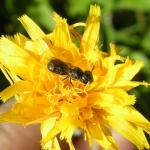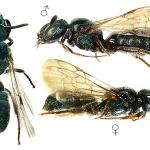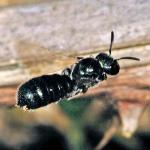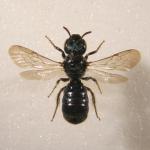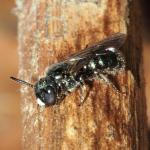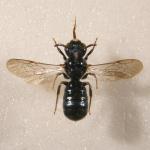Ceratina coerulea CHEVRIER 1872; Ceratina chevrieri TOURNIER 1876; Ceratina caerulea SCHENCKE 1859
This is the only example in Britain of a small 'carpenter bee', so-called because of its nesting habits - the female excavating its nest burrow in dead, pithy stems.
Ceratina cyanea was considered to be a great rarity in Britain until 1972, when it was found in abundance on a downland site in east Hampshire. Subsequently it proved to be widely distributed and locally common in south-east England (especially in the Weald: see distribution map of this area in Else, 1995c).
Listed as Rare (RDB3) in Shirt (1987) and Falk (1991). Recent records suggest that this species may be regarded as scarce.
South-facing chalk escarpments, heathland, disused sand quarries and open rides in deciduous woodland.
Single-brooded; May to late August, but adults can be found in every month of the year. Females can live about a year; there is evidence to suggest that some individuals of this sex may live for about 18 months (Else, 1995c).
Females excavate nesting burrows in dead, dry, broken woody or herbaceous stems in which the pith has been exposed. Most nests have been found in bramble (Rubus fruticosus agg.) stems, with a few in rose (Rosa sp.). The majority of nests seem to be in stems lying on or close to open ground: detached stems are regularly utilised. The cells are separated from one another by vertical partitions composed of compacted, fine wood-dust. From late summer onwards, adults of both sexes seek out hollow stems in which to pass the winter. Such hibernacula are similar to nest burrows but lack partitions. The bees enter the burrows head first and remain within, often in small aggregations, until the following spring. In a woodland site in east Hampshire many bees were found in the winter in stems of hemp-agrimony (Eupatorium cannabinum), but on nearby chalk grassland they were mainly in bramble stems (pers. obs.). The life history of this species in Britain is described by Else (1995c).
Bulbous buttercup (Ranunculus bulbosus), bramble (Rubus fruticosus agg.), tormentil (Potentilla erecta), burnet rose (Rosa spinosissima), viper's-bugloss (Echium vulgare), heath (Erica sp.) and germander speedwell (Veronica chamaedrys), thyme (Thymus sp.), wild basil (Clinopodium vulgare), self-heal (Prunella vulgaris), harebell (Campanula rotundifolia) and rough hawkbit (Leontodon hispidus).
In a Hampshire nest which had been opened, an ichneumonid larva (possibly Aritranis signatorius) was observed devouring a larva of C. cyanea (Else, 1995c).
Profile written: 1998
Proofed: February 2012


